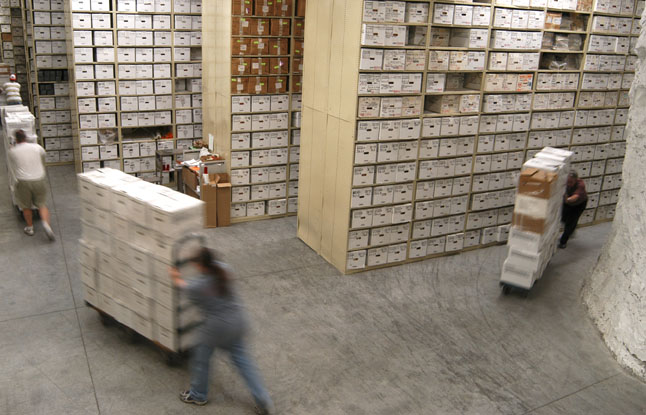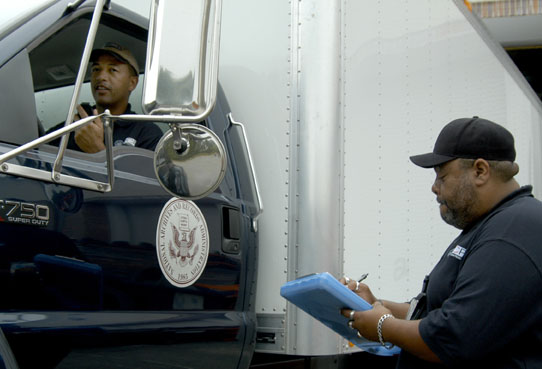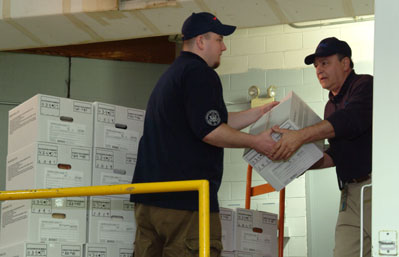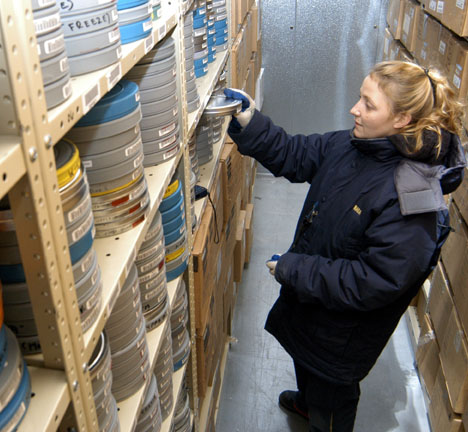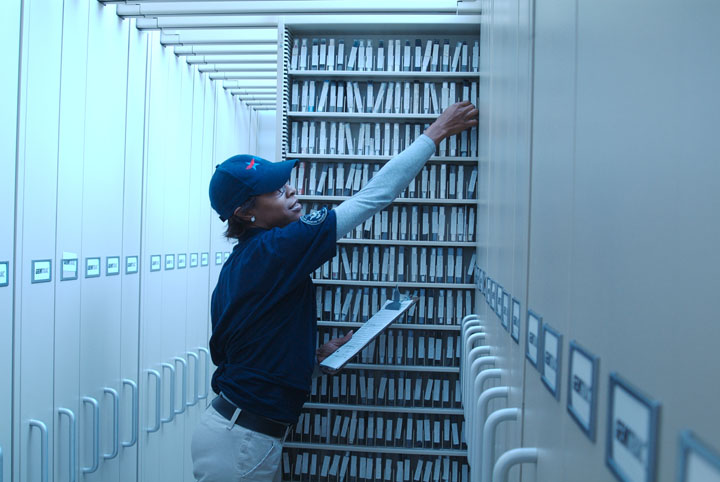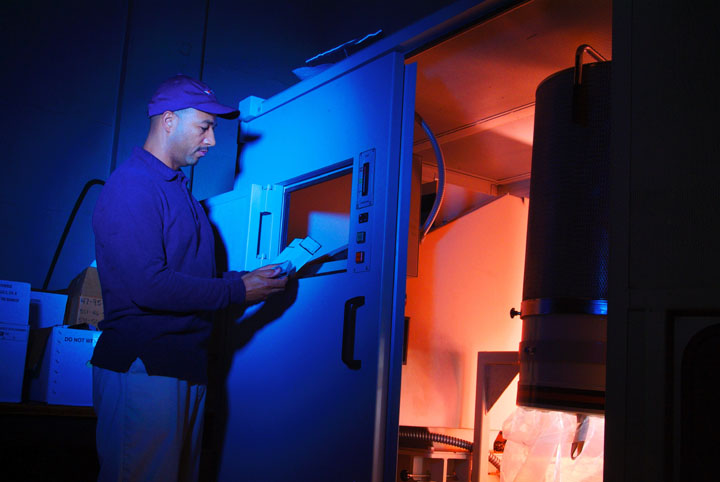
Ready Access: NARA's Federal Records Centers
Spring 2008, Vol. 40, No. 1
By Tara E. C. McLoughlin
When President George W. Bush nominated Judge Samuel A. Alito, Jr., in fall 2005 to serve on the United States Supreme Court, Congress, the press, and the public all wanted to know more about this nominee for the highest court in the land. What were his qualifications? Where did he stand on controversial issues? How had he ruled in previous cases?
To help them find answers, they looked to the federal records centers (FRCs) of the National Archives and Records Administration (NARA). As soon as the nomination was announced, the White House requested copies of every opinion in every case that Alito had heard during his 15 years on the bench at the U.S. Court of Appeals in the Third Circuit.
Staff at the Philadelphia FRC sprang into action, pulling more than 1,300 boxes containing Alito's rulings, opinions, and case files and making them available to Supreme Court and White House staff for the Senate confirmation committee hearings. Alito's federal records shaped the debate for his nomination and demonstrated how crucial records are to the functioning of our government.
Not all federal records are as high profile as the Alito court files, but all are important to the agencies that create them and to the citizens they affect. For more than 50 years, agencies have counted on NARA's federal records centers to keep these workaday records of the federal government safe and accessible.
Through its nationwide network of 17 facilities with more than 1,100 federal employees, the centers serve 400 federal agencies. FRCs store and service every kind of federal record—tax returns, claims files for military veterans, blueprints of federal buildings and structures, cancelled checks for Social Security payments and tax refunds, bankruptcy court records, inmate files on federal prisoners, and maps of national parks to name just a few. FRCs hold records for any citizen who has ever served in the military, had a Social Security number, or applied for a passport.
"The records that we hold and manage are essential to the functioning of the federal government today and to the documentation of federal transactions for the future," says David Weinberg, director of the Federal Records Centers Program (FRCP).
The volume of records housed in FRCs is staggering—more than 26 million cubic feet containing nearly 80 billion pages. If all the boxes stored in FRCs were stacked on top of each other in a single column, they would be taller than 900 Mount Everests. The volume of transactions processed is also massive—FRCs fulfill an average of 13 million reference requests a year, or 6,000 requests every hour.
The records in the physical custody of FRCs legally belong to the federal agencies that created them and generally can be requested only by authorized representatives of these agencies. However, a number of federal records can be accessed by the public under agreement with the owning federal agency.
The National Personnel Records Center (NPRC) in St. Louis, Missouri, stores and services personnel records of former members of the military and civil service. These records are very important for individuals to prove identity for key benefits, such as housing, medical care, and Social Security or even the right to be interred in a military cemetery. NPRC services approximately 2 million requests for military records each year. (See "20th-Century Veterans' Service Records: Safe, Secure—and Available" in the Spring 2005 issue of Prologue for more information about the NPRC.)
The public can also access federal court records held by FRCs. These records include files from U.S. bankruptcy courts, the U.S. court of appeals, and U.S. district court civil and criminal files. FRCs make court documents available for researchers such as reporters writing stories on high-profile cases, former bankruptcy court litigants applying for mortgages or other loans, companies conducting background checks on individuals, and legal professionals researching precedents.
When federal records are needed, their importance can be critical. FRCs specialize in providing ready access to the records in their holdings. In many regions, FRCs offer rapid delivery of requested records through the FRC Metro Courier service. This service provides same-day delivery of original documents to customers located within driving distance of an FRC. Customers who do not need original documents can get scans of their records delivered the same day via e-mail through the new SmartScan service, which was launched in October 2007.
Key FRC staff are also on call around the clock to handle emergency requests. "If an airplane crashes outside the United States, we will get an emergency call from the State Department's Passport Division, occasionally in the middle of the night, to come to the center and pull one or more passport applications for those listed on the passenger list," says Alan Kramer, director of the Washington National Records Center in Suitland, Maryland. "These documents provide the authorities with an address of record, a recent photograph, and information concerning the next of kin," Kramer adds. "These items aid in the identification of Americans involved in these kinds of accidents. In most cases, we can locate and retrieve this information within a matter of hours, anytime, day or night."
The federal records centers have also played a crucial role in disaster planning and recovery. Regional staff train agencies on storing vital records and continuity of operations planning. After a disaster, FRCs help agencies with recovery efforts. For example, after Hurricanes Katrina and Rita devastated the Gulf region, the Fort Worth FRC assisted with the cleanup and restoration of federal records damaged by the storms. These efforts included coordinating with contractors while evaluating and restoring records, separating and properly destroying nonrecord material, digitizing displaced records for future reference, and training those involved in recovery efforts to properly safeguard personal information in the documents.
In addition to providing post-disaster services to federal agencies, FRCs also provided crucial assistance to individuals. Many people lost not only their houses and possessions to the 2005 hurricanes but also their personal records. Some were left without a single scrap of paper to prove who they were—no driver's license, no passport, no birth certificate. In the aftermath of the storms, the NPRC saw an uptick in requests from veterans in the affected areas desperate for any documentation that would help them prove their identities, qualify for benefits, and begin to rebuild their lives. The NPRC instituted special procedures to identify and give priority processing to requests from these affected veterans.
Upon seeing the vast volume of holdings in FRCs, it is tempting to think that when it comes to records, the federal government keeps everything, forever. However, the majority of federal records—approximately 95 percent—are considered "temporary records." Every temporary record has an official records retention schedule—that is, the amount of time it must legally be preserved for use before it is destroyed (usually by recycling). Retention schedules for temporary federal records vary widely, ranging from a few months to more than a century. For example, most agency information request correspondence is kept for less than a year. Individual tax returns are preserved for seven years. Corporate tax returns, while not considered "permanent," must be retained for 75 years. And certain aircraft certification engineering files must be kept for 100 years.
In addition to storing and servicing temporary records, FRCs play a key role in the lifecycle of permanent records. Permanent records, as the name suggests, are records that warrant preservation by the federal government beyond the time they are needed for administrative, fiscal, or legal purposes because of their historical or other value. FRCs protect and preserve permanent records from the time they are no longer needed for daily business until they are accessioned into the National Archives. Archival control of the permanent records is assured because the records are in continuous federal custody for their entire lifecycle. About 90 percent of textual permanent records that are accessioned into the National Archives have come through the federal records center system.
"The federal records centers are the foundation of the bridge that connects the public to the history of their government," says Archivist of the United States Allen Weinstein. "The work of the centers ensures that the archives which form that bridge are strong, solid, reliable, and authentic documentary resources."The agencies of the federal government did not always have a place to safely store their records. Before the establishment of the National Archives in 1934, agencies were on their own when it came to records management. Early efforts were inconsistent. Some agencies saved everything, while others saved nothing. Devastating fires at agencies such as those at the Department of the Treasury (1800), the Patent Office (1877), and the Department of Commerce (1921), destroyed millions of federal records.
During its first few years in existence, the National Archives gained responsibilities for preserving and managing the temporary, day-to-day records of the federal government as well as the permanent, archival records. In 1950 the Federal Records Act further expanded this records management role, and the agency began to establish a network of records centers around the country. Since that time, the FRC system has grown to its current size to serve federal agencies in Washington, D.C., and around the country.
Over the years, the holdings in FRCs have steadily increased. When funds appropriated by Congress to operate the FRC system no longer kept up with the demand from agencies for services, Public Law 106-58 established a revolving fund to operate the centers. Since October 1, 1999, the Federal Records Centers Program has been supported entirely by the fees it charges to other agencies and has operated successfully every year.
"The structure of the revolving fund has given FRCs the flexibility to change, grow, and better respond to our agency customers' needs," says Weinberg. "This has been crucial in containing costs, developing new services, expanding storage capacities for a wide variety of records, and in helping us to better serve federal agencies and select public constituencies."
This flexibility in funding has also helped the federal records centers to invest in facility upgrades. All FRCs comply with strict federal regulations that govern facilities that store federal records. In 2009, even more stringent facility regulations will take effect, and the FRCP is making great strides to ensure that all of its facilities meet them. In some cases, this means retrofitting facilities with upgrades. In others, it involves moving out of an old facility into new space. Since the inception of the revolving fund, the FRC system has opened new facilities in Lenexa, Kansas; Dayton, Ohio; Atlanta, Georgia; Riverside, California; and Fort Worth, Texas. New facilities are planned in St. Louis, Missouri, and Denver, Colorado, as well.
Each of NARA's federal records centers has unique capabilities to serve customer needs. Some of the most interesting and flexible space in the FRC system is located 80 feet underground. Lee's Summit, Missouri, and Lenexa, Kansas, are home to limestone mines that have been retrofitted to store federal records. The mines feature natural climate controls that keep records at the proper temperature and humidity and are extremely cost-effective when compared to above-ground storage facilities. The Lenexa FRC houses a custom-built cold storage vault that stores film for the National Archives. The collection includes images from the CORONA program (the first successful satellite reconnaissance system employed by the United States) as well as film coverage of most of the wars the United States was involved in during the 20th century.
Managing electronic records is a growing need for federal agencies. The FRCs are responding to that need by developing services to help agencies store and preserve their electronic records. In 2007 NARA opened two electronic records vaults at the FRCs in Suitland, Maryland, and Fort Worth, Texas. These state-of-the-art vaults feature a non-aqueous fire suppression system, strict environmental controls, and multiple levels of security. In tandem with the opening of the vaults, the FRCs are launching a full suite of electronic records services, including scanning to convert paper records to digital images, backup tape rotation, and secure destruction for electronic media.
While launching services to manage e-media and help agencies with the transition from paper to electronic recordkeeping, FRCs are also laying the groundwork for online electronic records services using NARA's Electronic Records Archives (ERA). The vision of the ERA project from the beginning included building the "capability to manage federal agency electronic records within the NARA records center system" in addition to the capability to store and preserve permanent electronic records for the National Archives.
As the business of the federal government becomes more computer-based, FRCs are embracing new technologies to better manage and service the records in their custody. For the last several years, FRCs have been developing the Archives and Records Centers Information System (ARCIS). When fully deployed, ARCIS will be the online portal through which NARA's customer agencies will do business with FRCs and will automate and streamline workflow.
The federal records centers have ably served the federal government and the citizens of the United States for more than 50 years. As the needs of federal agencies change and grow, NARA's FRCs are also changing and growing to ensure that they will continue to protect the information assets of the federal government.
To learn more about the Federal Records Centers Program and its services, visit the FRC web site at www.archives.gov/frc.
Tara E. C. McLoughlin has served as the communications and marketing specialist for the Federal Records Centers Program since 2003. She previously served in a number of public affairs and outreach positions at several private sector and nonprofit organizations, including the American Physical Society, the American Association of University Women, and the European Union Delegation to the United Nations.
